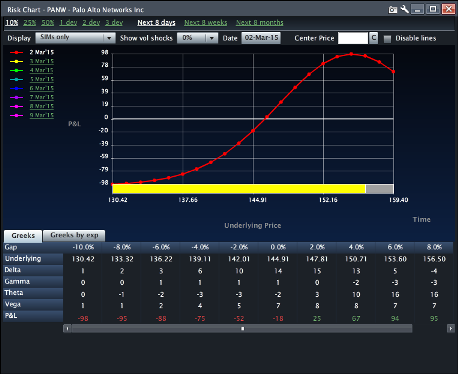When making a bullish directional play, why would I consider a call calendar and not just buying a call vertical or selling a put vertical?
A Quick Review
A call vertical is when you buy (or sell) a certain strike and sell (or buy) a call with a higher strike price. For example, the PANW March 6th 150/155 would be an example of a call vertical. A calendar spread is when you buy (or sell) a strike in one expiration and sell (or buy) the same strike but different month. The PANW March 6th/ March 155 is an example of a call calendar.
For an earnings type of play, straight verticals tend to be binary in nature. You are either going to max out the spread or lose most if not all of your premium. Typically, you are paid well from a reward to risk perspective to take on a trade like this.
For example the March 6th call spread is trading ~1.60. Let’s calculate our reward to risk. The spread maxes out at $5.00 (width of the spread) less whatever premium we pay (max reward) divided by the most we can lose which is our premium paid ($1.60). ($5-1.60)/$1.60 = 2.125:1. Not too bad, but like I said above, we are either going to make $3.40 or lose our $1.60.
Calendar Spread
Let’s consider a calendar spread. If we buy the monthly March 155 calls and sell the March 6th 155 calls, we can buy this for about $1. The risk to reward is a bit less straight forward, as there is a level of subjectivity in modeling the post-earnings implied volatility. Using past performance on earnings, we can determine an average level IV will regress to. In this case we see that the March implied volatility on average goes to the 30% level. To be conservative, I want to model in a 10% to 15% cushion in determining where to put the weekly vol (it usually goes to even with the back or even below). So, we model this vol at the 35% level. This produces a risk graph like this:

We are still targeting the $155 strike level like in our call vertical, but you can see that although our max profit happens at the 155 level, we can theoretically make about $0.95. This is not even a reward to risk of 1:1. Why not do the vertical?
Because this gives us some room to be wrong. We see that if we are unchanged, we theoretically lose only about $0.015 and if we are down 2%, we lose only ~$0.50. If we are wrong with a straight directional move, I will lose my entire premium. I am willing to give up some reward to risk in order to construct a more positive profit and loss scenario.
#####
For more from Michael Shorr and tradingadvantage.com, please click here.




